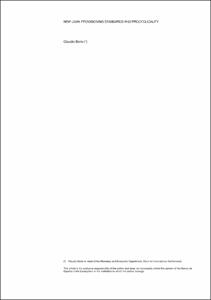Registro completo de metadatos
| Campo DC | Valor |
|---|---|
| dc.contributor.author | Borio, Claudio E.V. |
| dc.coverage.spatial | España |
| dc.date.accessioned | 2020-04-02T08:06:53Z |
| dc.date.available | 2020-04-02T08:06:53Z |
| dc.date.issued | 2019-05 |
| dc.identifier.uri | https://repositorio.bde.es/handle/123456789/11207 |
| dc.description | Artículo de revista |
| dc.description.abstract | The adoption of the new expected credit loss provisioning standard – IFRS 9 – is a landmark. What are its implications for financial stability? While the new standard is likely to mitigate the procyclicality of the financial system to some extent relative to the previous, incurred loss model, it falls short by a significant margin of what one would like from a financial stability perspective. This points to broader inevitable tensions between accounting and prudential regulation, and calls for the active use of backstops (or socalled prudential filters) to preserve stability. Experience with the operation of the alternative dynamic (countercyclical) credit loss provisioning scheme adopted by the Banco de España points to some strengths and weaknesses in the broader macroprudential frameworks in which such arrangements are embedded. |
| dc.format.extent | 8 p. |
| dc.language.iso | en |
| dc.relation.ispartof | Revista de Estabilidad Financiera / Banco de España, 36 (primavera 2019), p. 117-124 |
| dc.relation.hasversion | Versión en inglés 123456789/11216 |
| dc.rights | Reconocimiento-NoComercial-CompartirIgual 4.0 Internacional (CC BY-NC-SA 4.0) |
| dc.rights | In Copyright - Non Commercial Use Permitted |
| dc.rights.uri | https://creativecommons.org/licenses/by-nc-sa/4.0/deed.es_ES |
| dc.rights.uri | http://rightsstatements.org/vocab/InC-NC/1.0/ |
| dc.title | New loan provisioning standards and procyclicality |
| dc.type | Artículo |
| dc.identifier.bdebib | 000465595 |
| dc.identifier.bdepub | REFI-2019-36-117 |
| dc.subject.bde | Riesgos y liquidez |
| dc.subject.bde | Regulación y supervisión de instituciones financieras |
| dc.publisher.bde | Madrid : Banco de España, 2019 |












